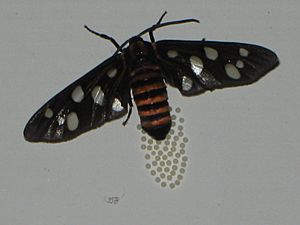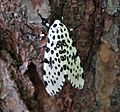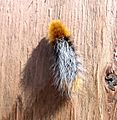Arctiinae facts for kids
Quick facts for kids Arctiinae |
|
|---|---|
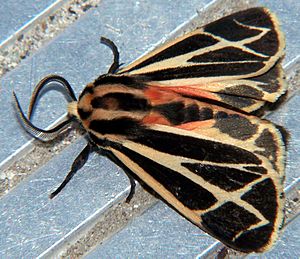 |
|
| Harnessed tiger moth Apantesis phalerata |
|
| Scientific classification |
|
| Kingdom: | Animalia |
| Phylum: | Arthropoda |
| Class: | Insecta |
| Order: | Lepidoptera |
| Superfamily: | Noctuoidea |
| Family: | Erebidae |
| Subfamily: | Arctiinae Leach, 1815 |
| Type species | |
| Arctia caja (Linnaeus, 1758)
|
|
| Diversity | |
| 1,400–1,500 genera Approximately 11,000 species |
|
The Arctiinae are a huge group of moths. There are about 11,000 different kinds, found all over the world. This group used to be called the Arctiidae family.
Many of these moths are known as tiger moths. They often have bright colors. Other types include footmen (which are usually duller), lichen moths, and wasp moths. Many species have caterpillars that look very "hairy". People often call these caterpillars woolly bears or woolly worms. The scientific name, Arctiinae, comes from a Greek word meaning "a bear," because of their hairiness.
Contents
How Moths Are Grouped
Moths and other living things are put into groups. This helps scientists understand how they are related. The Arctiinae used to be a family called Arctiidae. Now, scientists have learned more about them. They found that these moths are closely related to other groups. These groups include litter moths and Old World Aganainae.
Because of this new information, the Arctiidae family is now a subfamily. It is called Arctiinae. It belongs inside a larger family called Erebidae. This change helps show how these moths are connected to other moths. It keeps the smaller groups of moths organized.
| Old Group Name | New Group Name |
|---|---|
| Family: Arctiidae | Family: Erebidae |
| Subfamilies: Arctiinae, Lithosiinae, Syntominae | Subfamily: Arctiinae |
| Tribes: Arctiini, Lithosiini, Syntominae | Tribes: Arctiini, Lithosiini, Syntomini |
Main Groups of Arctiinae
Many kinds of Arctiinae moths are placed into these main groups, called tribes:
- Arctiini
- Lithosiini
- Syntomini
Some moths in this group are still being studied. Scientists are still deciding where they fit best.
What Makes Them Special
Arctiinae moths have a special organ on their body. It is called a tymbal organ. This organ can vibrate very fast. It makes sounds that humans cannot hear, called ultrasonic sounds. They also have special "ears" on their chest. These are called tympanal organs. They help the moths hear sounds. These organs are unique to this group of moths.
Other special features include certain hairs on their caterpillars. Their wings also have a unique pattern of veins. Female moths have a pair of glands near where they lay eggs. The sounds they make are used for finding mates. They also use them to protect themselves from animals that want to eat them.
Warning Colors and Defenses
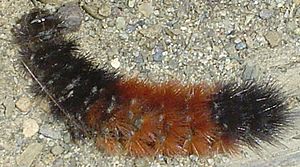
Many Arctiinae moths and caterpillars have a special defense. They get bad-tasting or poisonous chemicals from the plants they eat. Some can even make their own defenses. These chemicals can include things like cardiac glycosides or histamines. Caterpillars usually get these chemicals. They can keep them even when they become adult moths.
Adult moths can also get these chemicals. They might drink fluids from rotting plants that have the compounds. Adult males can even give these defenses to females. This helps protect the eggs. Some caterpillars have hairs that can sting. This is because they make histamines.
These insects show off their defenses with bright colors. This is called warning coloration. They might also use strange body positions or smells. Adult moths can even make ultrasonic vibrations. Some moths look like other poisonous insects. Some even look like wasps that sting. The ultrasound signals help animals like bats learn to avoid them. For some species, these sounds can even block a bat's echolocation.
Life and Habits
Many caterpillars and adult moths are active during the day. But most species in this group fly at night. Moths are often drawn to lights. However, one species, Borearctia menetriesii, never comes to light.
Caterpillars often warm themselves in the sun. This helps them digest their food faster. Some caterpillars live alone. Others live in groups. Like most caterpillars, they make a small silk pad before they shed their skin. They use this pad to hold on.
If a woolly bear caterpillar is bothered, it might roll into a tight ball. Or it might drop from its spot, hanging by a silk thread. Isabella tiger moths (Pyrrharctia isabella) spend the winter as caterpillars. They can survive freezing temperatures. They make a special chemical that stops them from freezing. Another species, Phragmatobia fuliginosa, can even be found on snow. They are looking for a place to turn into a pupa. Moths in cold places spend the winter as caterpillars.
Some tiger moths make ultrasonic clicks. They do this when bats use echolocation to find them. This helps protect the moths. Many caterpillars eat different kinds of plants. But a few, like the cinnabar moth (Tyria jacobaeae), eat only one type of plant.
Even though there are many Arctiinae moths, few cause problems for humans. For example, the fall webworm eats many types of trees. It has spread to Asia and Europe. But it usually does not cause lasting harm to healthy trees.
Woolly Bear Folklore
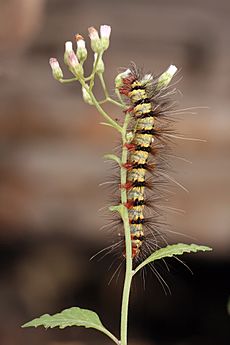
In parts of the American Northeast and South, people have a fun belief. They say that "woolly bears" can help predict the winter weather. This is similar to the groundhog tradition. People believe that the amount of black on an Isabella tiger moth's caterpillar shows how harsh the winter will be. More brown than black means a mild winter. More black than brown means a harsh winter.
However, scientists say this is just a myth. The amount of black on the caterpillar changes as it grows. It does not change because of the weather. This fun belief has led to festivals. There are Woollybear Festivals in Ohio, Beattyville, Kentucky, and Banner Elk, North Carolina.
Some Famous Arctiinae Moths
- Pale tiger moth, Halysidota tessellaris
- Banded woolly bear or Isabella tiger moth, Pyrrharctia isabella
- Buff ermine, Spilarctia lutea
- Cinnabar moth, Tyria jacobaeae
- Common footman, Manulea lurideola
- Dogbane tiger moth or delicate cycnia, Cycnia tenera
- Fall webworm, Hyphantria cunea
- Garden tiger moth, Arctia caja
- Grote's Bertholdia, Bertholdia trigona
- Giant leopard moth, Hypercompe scribonia
- Hickory tiger moth, Lophocampa caryae
- Jersey tiger moth, Euplagia quadripunctaria
- Milkweed tiger moth, Euchaetes egle
- Scarlet tiger moth, Callimorpha dominula
- Maltese ruby tiger moth, Phragmatobia fuliginosa ssp. melitensis
- Ornate moth, Utetheisa ornatrix
- Muxta, Muxta xanthopa
Gallery
-
Final stage of Euchaetes egle
-
Apantesis arge caterpillar
See also
 In Spanish: Arctinos para niños
In Spanish: Arctinos para niños


